
Login to view this content
Join Blender Studio for just €11.50/month and get instant access to all of our training and film assets!

Simple Bouncing Ball P.1
In this video Hjalti will talk about the animation principles Timing and Rhythm, Spacing and squash and Stretch. He will apply them to a bouncing ball.
Please download the blender file here
48 comments

does anyone know if these work with Blender 4.2 please?

@Mike Lambert
Not sure, but I'm about to give it a go with 4.3!

@Anthony van Dijk Hi, i just want too know if you cam right with this coruse in Blender 4.2? :)

@Anthony van Dijk me too!

why me guys dont be rude

boshhhhhhhhhhhhhhhhhhhhhhhhhh

i cant wait to learn to animate into full feature film thanks blender studio

Very interesting. I will say there are parts where things are not explained perfectly clearly but there are others where certain principles are explained very well. I think this will be much easier to understand if someone comes in with a bit of animation knowledge before hand just to help with the problem areas. Definitely a solid approach though to explaining things as long as understand the few areas where it's a bit jumbled.

outdated payed 12eu which is quite a bit in my country.For nothing wasted many hours of my life trying to figure out how to fix all of the rigs also many futeres are replaced or non existant now

@Nacho Conesa hi, you didn't explain the Rhythm by taking the seperate example....so can you share here withexample difference like what is rhythm and to which principle it's connected with...?

these blend files seem crash in blender 3.3 the don't open anymore sadly

He just blew my mind 5 minutes in...

3D body modeling

You explained it fantastically! Timing, Spacing, Squash and Stress... Thank You

Is there the possibiliy to publish the animations and get feedback?

Holy mama what a golden course. Blender Institute is the best cgi thing in this world. Thanks for this!

Graduated AM and looking for more to learn. Loving this series so far, would love to see more advanced acting topics in the future!

The comment section here is on fire. Thank you for the feedback. I've also signed up for blender cloud

I found this very informative. It also cleared up for me some concepts that I was thinking all to deep in.

When the ball stretches before impacting and squashing I guessing this is for visual appeal? I'm not sure if an object would do that physically.

@Joanne Seale It is a common technique to fake motion blur. It's been a standard for almost 100 years.

After completing the course, now I think this is the most important part of it!

I appreciate the videos, however, a ball doesn't stretch BEFORE it hits the ground. this ignores a fundamental principle. for an object to react to a force, the force must first be acted upon it. As its falling, its going to maintain its shape until it is squashed by the impact of hitting the ground. Once it hits the ground and squashes, then when it comes up up again, it will stretch as a reaction to being squashed by the ground. So. Its in the air, its round. It hits the ground, it squashes. It comes off of the ground and reacts to the squash by stretching a little, then settles back into its round state.

@bryanharrison369 I'd say this BEFORE stretching rather conveys our impressions of the behavior of things, and not reality itself. :)

@bryanharrison369 The force of gravity is dragging the ball down, the stretch is a visual representation of the force of gravity acceleration.

Honestly video is too long for only 3 principles of animation. For me same 3 principles are explained way better (visually) and quicker in below video. https://www.youtube.com/watch?v=uDqjIdI4bF4&list=PL-bOh8btec4CXd2ya1NmSKpi92U_l6ZJd&index=13

@d.zaleckis 3 animation principles are the basics for doing everything. If you don't understand this you can't do anything. Right give it a lot of space

@Maurizio Cordopatri true

Honestly, the sound effects of the ball moving are probably my favorite part. You know, in addition to the absolutely fantastic content.


Hello, can we do this in simulation?

@Huân Lê-Vương Yeah, but then there is no artistic soul in it and its harder to control.

Damn I've paid for subscription but never got here ..... Many thanks, great video I've learned a lot of :) , lol does remind fibonacci sequence

The lines you start drawing in relation to the bounce effect (5:41) started me thinking of the Golden Ratio and the Fibonacci number which, in my limited mind, are one and the same. If converted to units of measurements and reversed, you can almost map this animation out without the reference. For example, if you started with a unit of 34 for the first bounce, the next units of distance would be 21, 13, 8, 5, 3, 2, 1, 1 then zero.

Ok, this is probably Animator mentor but for blender! I subscribed to the cloud today and I'm super hyped seeing this here. can't wait to get started

This is so good, I learned so much in this video!

Bonjour, existe t-il une traduction française s'il vous plaît?

3:30 bouyancy = the ability or tendency to float in water or air or some other fluid. bounciness = the quality of a substance that is able to rebound

I learned and had as much fun. Thanks.

This is probably the best 3d animation course I've seen.

@Matt It's pretty good. But I will say that I took a lot away from the Animator's Survival Kit DVD course and that really helped overall especially in the areas in this video where some terminology problems popped up. Definitely a solid video still.

At around 31 minutes when discussing spacing favoring in the opposite direction of the bouncing ball, I found that imagining a "hovering" object acting like a spring w/ downwards force and then released helped visualize this in a setting/use case where you might want to apply this principle.

"Squash ANS", that reaction haha ;)

i wish there was a triple like button for this course. thank you for explaining the what and the why

Hjalti, just wanted to say I appreciate all these new animation courses, thanks for being so enthusiastic and thorough.

grrreen!
Good visual explanation of these concepts.

yaaay thanks for this

OMG, this all updated already? no excuse to miss it.
Join to leave a comment.